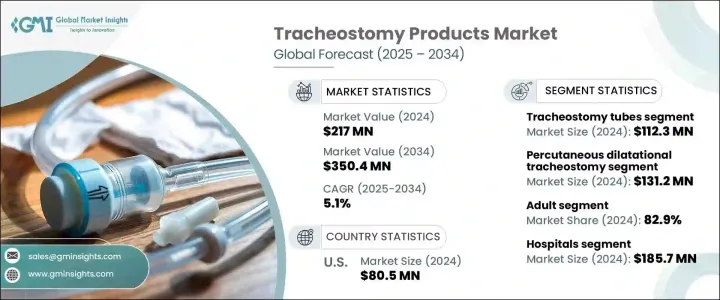
세계의 기관절개용 제품 시장은 2024년에 2억 1,700만 달러로 평가되었고, 2025년부터 2034년까지 CAGR 5.1%로 예측되어 큰 성장이 전망되고 있습니다.
이 확대는 기관절개 기술의 발전, 소아기도 장애 유병률 증가, 호흡 관리에 대한 의식 증가, 고령화 인구 증가 등 다양한 요인으로 인한 것입니다. 중환자 치료 입원 증가와 만성 호흡기 질환의 부담 증가를 배경으로 한 호흡 케어 솔루션에 대한 수요 증가는 시장의 가능성을 더욱 두드러지게 하고 있습니다. 또한, 항균 코팅, 카프레스 설계, 유연한 맞춤형 튜브 등 기관절개용 제품의 지속적인 혁신은 안전성, 편안함, 효율성 등 환자의 주요 요구를 충족시킵니다. 세계의 의료시설에서 이러한 최첨단 기술이 채용되고 있는 것은 동 시장의 유망한 궤도를 부조로 하고 있습니다.

이 시장은 제품 유형별로 분류되며 기관절개 튜브, 환기용 액세서리, 세정 및 케어 키트, 기타 관련 제품이 포함됩니다. 기관절개 튜브가 시장을 독점하며 2024년에는 1억 1,230만 달러를 창출했습니다. 이 튜브는 합병증을 최소화하면서 효과적인 환기를 촉진하기 때문에 기도 상태 관리에 필수적입니다. 항균 소재 및 혁신적인 디자인을 포함한 기관절개 튜브의 기술적 진보는 환자의 결과를 향상시키고 장기 호흡 관리의 전반적인 안전성을 높입니다. 또한 외상, 뇌졸중, 중증 감염으로 인한 심각한 환자 수가 증가함에 따라 병원과 재택 간호 모두에서 기관절개 튜브의 필요성이 증가하고 있습니다.
| 시장 범위 | |
|---|---|
| 시작 연도 | 2024년 |
| 예측 연도 | 2025-2034년 |
| 시작 금액 | 2억 1,700만 달러 |
| 예측 금액 | 3억 5,040만 달러 |
| CAGR | 5.1% |
시장은 절차별로 구분되며 경피적 확장 기관절개술과 수술적 기관절개술이 두 가지 주요 방법입니다. 경피적 확장 기관 절개술은 2024년에 1억 3,120만 달러를 차지했고, 저침습성으로 인해 선호되는 절차로 부상하고 있습니다. 이 방법은 작은 절개와 기관을 확장하기 위해 확장기를 사용해야 하므로 조직 손상이 적고 회복 시간이 단축되며 합병증의 위험이 낮아집니다. 중환자 치료의 현장에서 이 수술이 선호되게 된 것은 그 유효성과 저침습 수술에 대한 수요 증가를 반영하고 있습니다.
미국의 기관절개용 제품 시장은 2024년에 8,050만 달러를 창출으며, 2025년부터 2034년까지 연평균 복합 성장률(CAGR) 4.6%로 성장할 것으로 예상됩니다. 미국은 의료 기술 혁신, 특히 항균, 카프레스, 일회용 튜브 등의 고급 기관절개 솔루션 개발에 주력하고 있습니다. 이러한 진보는 환자의 안전과 편안함을 향상시키고 병원과 재택 간호 환경에서의 채용을 촉진하고 있습니다. 또한 장기 호흡 관리에 대한 유리한 상환 정책은 고품질 기관절개 제품에 대한 접근을 보장하여 시장 성장을 더욱 촉진하고 있습니다.
The Global Tracheostomy Products Market, valued at USD 217 million in 2024, is poised for significant growth with a projected CAGR of 5.1% between 2025 and 2034. This expansion stems from various factors, including advancements in tracheostomy technology, the increasing prevalence of pediatric airway disorders, rising awareness of respiratory care, and the growing aging population. The escalating demand for respiratory care solutions, driven by an increase in critical care admissions and the rising burden of chronic respiratory conditions, further underscores the market's potential. Moreover, continuous innovations in tracheostomy products, such as antimicrobial coatings, cuffless designs, and flexible customized tubes, are addressing key patient needs for safety, comfort, and efficiency. The growing adoption of these cutting-edge technologies by healthcare facilities worldwide highlights the market's promising trajectory.

The market is categorized by product type, encompassing tracheostomy tubes, ventilation accessories, clean and care kits, and other related products. Tracheostomy tubes dominated the market, generating USD 112.3 million in 2024. These tubes remain integral to the management of airway conditions, as they facilitate effective ventilation while minimizing complications. Technological advancements in tracheostomy tubes, such as antimicrobial materials and innovative designs, are enhancing patient outcomes and improving the overall safety of long-term respiratory care. Additionally, the rising number of critical care cases caused by trauma, strokes, and severe infections has amplified the need for tracheostomy tubes in both hospital and home care settings.
| Market Scope | |
|---|---|
| Start Year | 2024 |
| Forecast Year | 2025-2034 |
| Start Value | $217 Million |
| Forecast Value | $350.4 Million |
| CAGR | 5.1% |
The market is also segmented by technique, with percutaneous dilatational tracheostomy and surgical tracheostomy as the two primary methods. Percutaneous dilatational tracheostomy accounted for USD 131.2 million in 2024, emerging as the preferred technique due to its minimally invasive nature. This method involves a small incision and the use of a dilator to enlarge the trachea, which results in less tissue damage, faster recovery times, and a lower risk of complications. The growing preference for this technique in critical care settings reflects its effectiveness and the increasing demand for minimally invasive procedures.
The U.S. tracheostomy products market generated USD 80.5 million in 2024 and is expected to grow at a CAGR of 4.6% between 2025 and 2034. The United States leads in medical technology innovation, particularly in developing advanced tracheostomy solutions such as antimicrobial, cuffless, and disposable tubes. These advancements enhance patient safety and comfort, driving adoption in hospital and home care environments. Additionally, favorable reimbursement policies for long-term respiratory care ensure accessibility to high-quality tracheostomy products, further fueling market growth.